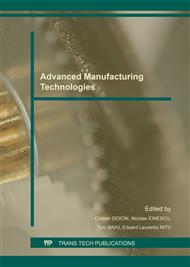[1]
K. Tahera, C.M. Eckert, C.F. Earl, Optimizing Overlap between Testing and Design in M. Abramovici, R. Stark (Eds. ), Smart Product Engineering: Proceedings of the 23rd CIRP Design Conference, Bochum, Germany, March 11th - 13th, 2013, Springer-Verlag Berlin Heidelberg, 2013, pp.201-210.
DOI: 10.1007/978-3-642-30817-8
Google Scholar
[2]
J. Sahno, E. Shevtshenko, T. Karaulova, K. Tahera, Framework for Continuous Improvement of Production Processes, Inzinerine Ekonomika-Engineering Economics 26(2), (2015) 169–180.
DOI: 10.5755/j01.ee.26.2.6969
Google Scholar
[3]
M. S. Yang, Y. Li, Y. Liu, X. Q. Gao, A Method for Problem Selection in the 6σ Definition Stage, Advanced Materials Research, Vols. 139-141, Oct. (2010) 1485-1489.
DOI: 10.4028/www.scientific.net/amr.139-141.1485
Google Scholar
[4]
V. Karandikar, S. Sane, S. Sane, S. Jahagirdar, S. Shinde, Process Improvement in a Filter Manufacturing Industry through Six Sigma DMAIC Approach, International Journal of Current Engineering and Technology, Vol. 4, No. 4 (2014) 2546- 2556.
Google Scholar
[5]
D.H. Stamatis, Failure Mode and Effect Analysis: FMEA from Theory to Execution, second ed., ASQC Press, New York, (2003).
Google Scholar
[6]
A. Misztal, Technical Determinants of Success in Quality Management Systems Implementation in the Automotive Industry, World Academy of Science, Engineering and Technology, International Journal of Social, Behavioral, Educational, Economic and Management Engineering Vol: 9, No: 8, (2015).
Google Scholar
[7]
Chrysler Corporation, Ford Motor Company, General Motors Corporation, Potential Failure Modes and Effects Analysis (FMEA). Reference Manual, 4th ed., (2008).
Google Scholar
[8]
C. Ştirbu, C. Anton, L. Stirbu and R. Badea, Improved By Prediction of the PFMEA Using the Artificial Neural Networks Proceeding of International Conference on Applied Electronics, Czech Republic, Pilsen, September (2011) 1-4.
Google Scholar
[9]
A. Mazare, L. Ionescu, G. Serban, V. Barbu, Evolvable Hardware with Boolean Functions Network Implementation, Proceeding of International Conference on Applied Electronics, Czech Republic, Pilsen, September (2011) 1-6.
Google Scholar
[10]
K. Paneerselvam, S. Aravindan, A. Noorul Haq, Hybrid of ANN with genetic algorithm for optimization of friction vibration joining process of plastics. J. Advan. Manuf. Technol. 42 (2009) 669–677.
DOI: 10.1007/s00170-008-1641-z
Google Scholar


